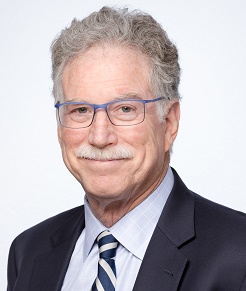Conversations in Cardiology: ISCHEMIA’s Lasting Fallout
Morton Kern, MD, often engages his colleagues via email in brief, informal dialogue on clinically relevant topics in cardiology.

 Morton Kern, MD, of VA Long Beach Healthcare System and University of California, Irvine, often engages his colleagues via email in brief, informal dialogue on clinically relevant topics in interventional cardiology. With permission from the participants, TCTMD presents their conversations for the benefit of the cardiology community. Your feedback is welcome—feel free to comment at the bottom of the page.
Morton Kern, MD, of VA Long Beach Healthcare System and University of California, Irvine, often engages his colleagues via email in brief, informal dialogue on clinically relevant topics in interventional cardiology. With permission from the participants, TCTMD presents their conversations for the benefit of the cardiology community. Your feedback is welcome—feel free to comment at the bottom of the page.
Peter Block, MD (Emory University, Atlanta, GA), asks:
I recently reviewed some cases that posed a changing issue—some interventional docs are now following ISCHEMIA and are deferring PCI for medical Rx. That leads to unhappy referring non-PCI docs who seek other interventionalists, which makes everyone unhappy. Education of trials might help, but 90+ % LAD lesions still inspire fright.
Additionally some hospitals are now struggling with dropping intervention numbers for competence—as are some interventionalists and hospitals worried about what defines ongoing competence.
How do we best deal with these complex issues? Lawyers are lurking.
Great question. I think there are three issues in play.
First, following the ISCHEMIA trial, selecting medicine over PCI as an initial step is supported by data in the appropriate patients. Medical treatment until refractory ischemic symptoms develop followed by PCI is appropriate, too. Secondly, the interventionalists conditioned the referring MDs to expect PCI and now the referring MDs can't change course, and as you put it everyone's disappointed and probably to the detriment of the patients.
Thirdly, since the ISCHEMIA trial and others demonstrating equipoise for medical versus PCI for stable ischemic heart disease (SIHD) outcomes with intermediate stenosis, PCI volumes have declined. Administrators who help build large programs and revenues based on PCI projections are disappointed, and physicians needing certain volume numbers, likewise, have to reset their expectations. I doubt FFR/iFR has been much of a contributor to the procedure reduction, since many operators eschewed the technique for the very reason it might reduce their caseload.
I'm not sure why the angst about this.
Setting expectations seems the only way to manage all parties, interventionalists, referring MDs, administrators, and lawyers. There's always been a trend toward more PCI than less for these patients, and now the tables turned? Am I missing something?
Jeffrey Moses, MD (NewYork-Presbyterian/Columbia University Irving Medical Center, New York, NY):
Well, some of us do not see the equipoise in ISCHEMIA from the patient-oriented outcomes. 1) If you have even moderate symptoms (ie, weekly) PCI gives you an immediate and sustained improvement in QoL over meds. No equipoise there. 2) Your risk of type 1 MI is increased with medical therapy. No equipoise there. 3) Your risk of cardiac death is increased with meds. 4) If you have reduced LV function or complex disease your outcomes are better versus med Rx. Yes, med Rx isn't immediately dangerous in many anatomic configurations, but we need to be our own advocates for a procedure with clear benefits over meds in many scenarios. Remember this study was a test of whether or not you should cath for ischemia with mild symptoms, not a test of revascularization per se. Forty percent of both groups had the same Rx, and yet revascularization had these benefits nonetheless.
Teach them . . .
William Fearon, MD (Stanford University School of Medicine, CA):
I agree. We have robust data from COURAGE, FAME 2, and ISCHEMIA clearly showing better angina relief and improved quality of life with revascularization and in particular PCI compared with medical therapy, and at no increased cost in cardiac events. In fact, in FAME 2 at 5 years there was a significant reduction in all MI, and in ISCHEMIA there was a significant reduction in spontaneous MI. At 3 years, the costs between PCI and medical therapy in FAME 2 were no different and the PCI group still had significant angina relief despite a crossover rate of about 50% in the medical therapy arm.
I think it is also important to remember who was included in ISCHEMIA. Thirty-four percent of patients had no angina in the past month, 44% had monthly angina, and only 2% had daily angina. In fact, an exclusion criterion was “Canadian Cardiovascular Society (CCS) Class III angina of recent onset, or angina of any class with a rapidly progressive or accelerating pattern”.
My take-home points from ISCHEMIA include that we do not need to rush stable patients to the cath lab when they have abnormal stress tests (assuming we know the status of their left main from a coronary CTA). We can give medical therapy a try to see if symptoms resolve. In addition, ISCHEMIA suggests no need for stress imaging studies, but in a patient with stable and minimal symptoms just do a coronary CTA (plus/minus FFR-CT). As far as in whom to perform PCI, it hasn’t really changed my practice; if a patient has significant angina and a functionally significant lesion in a major epicardial vessel and is aware of the pros and cons of PCI versus medical therapy and chooses PCI, then I think it is reasonable to perform PCI to improve quality of life.
Kreton Mavromatis, MD (Emory University School of Medicine, Atlanta VA Medical Center, GA):
I agree with Bill's points. The only changes that ISCHEMIA may have encouraged in me when referred a patient for cath are 1) no need to rush to the cath lab for any size perfusion defect in the stable patient with CCS 0, 1, 2 stable angina, 2) an attempt at some basic anti-ischemic therapy is encouraged (many patients need something for their hypertension anyway) while he/she is waiting for their cath appointment, 3) no promises of major benefit to patients without true angina symptoms (careful history and sometimes with exercise tolerance testing when in doubt), or high-risk multivessel disease (MVD) or left main disease when anatomy is known by coronary CT angiography (CCTA).
I think ISCHEMIA should mostly affect the practice upstream from the cath lab, before referral to the cath lab—more careful history, more CCTAs (to define anatomy) and exercise tolerance testing (to help establish the cause and level of symptoms) when feasible, an attempt at optimizing BP control with anti-ischemic meds, and an honest discussion of the general benefits of revascularization. All this is in the referring doctor's “wheelhouse.” The problem is this is not only a change from the way many referring doctors practice, but it is also more time-consuming/difficult.
Kirk Garratt, MD, MSc (ChristianaCare, Newark, DE):
ISCHEMIA showed that PCI as a first step in patients with SIHD doesn’t prevent adverse events. If you’re not sure that’s right, take a look at table 2 in the main ISCHEMIA paper (N Engl J Med. 2020;382:1395-1407). PCI didn’t help even in those with the greatest ischemic burden on stress testing (Circulation. 2021;144:1024-1038). We shouldn’t have a problem with this: if we were GI docs, none of us would cauterize a nonbleeding peptic ulcer in somebody who hasn’t had guideline-directed medical therapy, even if it looked nasty, and we’d be really critical of somebody who did that to prevent a future bleed without good evidence of efficacy.
Maybe we’ll learn that the late reduction in spontaneous MIs is enough to change things, but right now we have to be honest about the findings. This doesn’t mean patients never get PCI: if symptoms develop/persist despite meds, it’s time to escalate care, because as Jeff pointed out, ISCHEMIA and other trials confirm benefit with respect to functional status. But the argument that a preemptive PCI will stave off horrible events just hasn’t been borne out despite decades of trying to prove it’s true.
The claim that patients enrolled in ISCHEMIA don’t look like our patients is tough to swallow. We’ve all had tons of asymptomatic/minimally symptomatic patients referred for cath because of a finding on a stress test. In the past, we’d find something and put in a stent rather than work with referring MDs and patients to enhance medical therapy. This has to be called out as bad medicine now; I know this group of leaders has changed practice accordingly.
As Mort said, we’ve trained our referring docs to expect treatment when they send patients to us. We need to train them to expect collaborative care planning now. This should strengthen, not weaken, referral patterns.
Finally, as Kreton said, ISCHEMIA has accelerated use of CCTA, especially when CT-FFR is available. We need to remind referring docs that in most patients, CCTA can really help keep patients out of the lab when a cath isn’t needed, and help make sure patients who need cath get one.
Ajay Kirtane, MD (NewYork-Presbyterian/Columbia University Irving Medical Center):
Kirk: I may be misinterpreting, but to me this seems like a common misinterpretation of the ISCHEMIA trial. First, the trial didn’t study PCI, it studied cath/angiography. While I would fully agree with the overall sentiments of what you wrote (regarding using more discretion regarding when to treat, understanding that medical therapy is important, etc), I don’t think that the analogy of a nasty ulcer fits. If one looks for example at the breakdown in events based upon disease severity, a gradient of effect (even within a study like ISCHEMIA that is diluted by patients who don’t even get revascularized) begins to emerge from figure 3 of the main paper. Combine this with the fact that—despite early procedural events—at 4 years there was a reduction in CV death/MI with the invasive arm (see also the Bayesian analysis in the appendix).
In short, I don’t think that an appropriate message is that it’s totally fine to take a nasty-MVD patient and invoking the ISCHEMIA trial to just treat them medically. In those cases, I use the trial to present options, but I still recommend revascularization and involve my surgical colleagues of course in the decision-making. This is also BTW supported by the Class IIa guideline recommendation for revascularization to reduce CV events (such as spontaneous MI, unplanned urgent revascularizations, or cardiac death) among patients with MVD.
Garratt:
Great points, Ajay. I suspect we all agree that the marginal subsets from the ISCHEMIA population (and at least some other trials) don’t fit conclusions based on study population means. In ISCHEMIA, patients with severe MVD treated with early revascularization had a lower rate of MI + CV death (Harmony Reynold’s Circulation paper from 2021); since this was a relatively small subset of about 650 patients, the observation wasn’t powered well enough to be the last word, but it passes the sniff test for me. You can make similar arguments about patients with mild-to-moderate reductions in LVEF. My comments before were aimed at the more common one- to two-vessel disease stuff that we used to treat with abandon and now need to be more circumspect about.
Samuel Butman, MD (Heart & Vascular Center of Northern Arizona, Cottonwood):
Everything, and I do mean everything, that has been written on this thread has appropriately hit on the oversimplification as well as the underrepresentation of the deficiencies of the ISCHEMIA trial findings. That being said, what has not been touched on is the reality of the overuse of stress testing in the management of stable ischemic heart disease, be it symptom-free or stable angina patients. A stress test, typically with imaging, is an important financial reality for too many providers and is not likely to stop being so in the foreseeable future. While CTA may be equal or better, it is not yet a viable tool (financial or otherwise) for many. The referring provider faced with an abnormal result feels compelled to refer for angiography and what follows remains part of the DNA of most interventionalists for a myriad of reasons. The real underlying finding in the ISCHEMIA trial to me was that too many stress tests are being done in stable patients with coronary artery disease. Stop the entry of unnecessary patients in the revascularization pipeline (ie, cath +/- possible intervention) and Dr. Block’s (and our) dilemma may not be the issue any longer.
Lloyd Klein, MD (UCSF Medical Center, San Francisco, CA):
The surprising thing to me is that anyone is really surprised by ISCHEMIA. We have known the limitations of PCI to produce survival benefits since COURAGE and even before. Once the entry criteria were weakened to include moderate sized defects, the fix was in. There will be a decrease in referrals for a while but it will increase again, just as it did after COURAGE. These things have a pattern to them. The real problem is that programmatic decisions as to compensation and man power assume a certain volume. We as a profession have not been on the leading edge of that discussion, and so when a study like this becomes widely known, it impacts the bottom line. Individual operators, like many of those on this listserv, have recognized this issue for many years, even decades, and it hasn’t impacted us as much.
Moses:
The message from ISCHEMIA is that anatomy is destiny and 10% or so of patients have left main disease, so in cases of suspected disease, anatomic delineation is essential. The ISCHEMIA issue was never actually settled, in that most "severe " cases were simply EKG stress. The original concept of a 10% of LV threshold was sidelined due to poor recruitment.
James Blankenship, MD (University of New Mexico, Albuquerque):
Going back to Mort’s three points:
#1: These comments have centered on the role of PCI in stable ischemic coronary disease (SICD). We can argue the fine points, but I think the major points are that SICD is stabler than we thought decades ago, deserves optimal medical therapy, and in some cases is benefited by PCI, in many cases determined by patient preference.
#2: Referring docs conditioned to expect PCI. I think referring docs are mainly motivated by the desire to shift risk. They don’t want to sit on a patient with coronary disease who then has an MI and blames them. We did a little quality-improvement project a few years ago where we screened patients referred directly for cath. Those for whom the referral was inappropriate, I called the referring doc and talked it out. They seemed satisfied as long as we basically took responsibility for the patient off their shoulders. So I think if interventionalists commit to following and helping manage SICD patients, the referring docs will be happy even if PCI is not done.
#3: Declining PCI volumes. PCI volumes have been on a more or less steady decline since 1996, and studies even prior to COURAGE sounded the alarm that PCI in SICD was of limited value. As a profession we have been dealing with the consequences of declining numbers for two to three decades, including questions of numbers needed to maintain competency and programs. Hospitals have dealt with this by building structural programs. Individuals have accommodated by augmenting their practice with structural or peripheral procedures or accepting that they will have a low-volume PCI practice.
The Bottom Line From Mort Kern
The conversation about the benefits of medical therapy and timing of revascularization continues because each patient must have a tailored and specific approach for their presentation, preferences, and expectations. The interventionalists want to help by treating symptoms with revascularization, sometimes ahead of the trial of optimal medical therapy. None should be unhappy with providing the patient with options from what is considered your best advice, even when the approach is not what a trial may say. The issue of doing things to increase or decrease procedure volumes must take a back seat to good patient care regardless of its effect on numbers of the cath lab procedures.



Craig Thompson